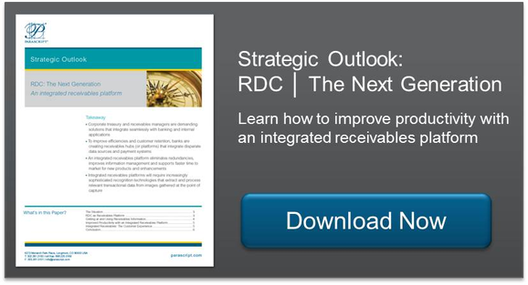This year’s annual Remote Deposit Capture summit was held in Orlando, Sept 25-27. It is a fascinating niche event that unlike many industry conferences evolves dramatically each year. And for the financial industry, which tends to be slow about technology adoption; watching the evolution of this space is really interesting.
Here’s a summary of the top themes at this year’s summit, and some takeaways as it relates to capture and recognition.
Top 3 themes from the RDC Summit
1) Mobile RDC is hot! Two years ago Chase was leading the way in this space. Last year, most banks seemed to be determining the strategy. This year, there was an overwhelming sense of acceptance; albeit concern about fraud.
2) Concerns about mobile RDC fraud. Specifically, how does one prevent a check from being deposited multiple times. In summary, there are two common scenarios:
- Same bank, duplicate deposit – check is deposited by phone and taken to the branch later (most often inadvertently). Check is deposited twice. This can be addressed with same bank reconciliation, and is not the major source of concern.
- Multiple banks or cashiers, duplicate deposit – check is deposited via mobile at bank 1, then again at bank 2, and potentially a 3rd time at a retail cashier. This creates back-end confusion about who must honor the deposit.
3) The future of RDC – specifically, RDC is uniquely positioned as a data capture platform, akin to the strategic outlook about integrated receivables hubs we wrote about last year. Get the white paper here.
What does this mean for capture and recognition?
As banking functions continue to decentralize, capture and recognition becomes vital. And while the volumes aren’t necessarily high (check usage on a whole has been declining); the convenience of distributed capture provides critical differentiation and customer services for banks and credit unions. And the applications continue to grow.
Let’s review the three themes above from the lens of capture and recognition.
Mobile RDC is hot! Capture and recognition are critical for ingesting a check for deposit. This area is maturing but continuing to be refined, specifically in the areas of fraud prevention.
Concerns about mobile RDC fraud. Recognition provides two very distinct anti-fraud functions here in terms of restrictive endorsement and signature presence detection.
- One dirty little secret about this new space is that a number of checks are deposited without a payees signature. Recognition can be used to detect a signature’s presence and provide feedback to a mobile user if a signature is not there. Secondly, a payee signature can be validated against a signature on file for an additional layer of security. Learn more about how signature verification works here.
- A second opportunity is restrictive endorsement. Recognition engines can be utilized to look for specific keywords in the endorsement line, such as For deposit at [bankname]. If this is not detected or validated with a certain level of confidence, the mobile app could refuse the deposit or return a suggestion to the user to write in the restriction. This restriction is of high interest as it indicates to a 3rd party check casher that the check has already been cashed and that they should reject it.
The future of RDC. RDC Summit founder, John Leekley, is a big proponent of the potential for the future of RDC. If we step back and look at the RDC platform not only as a means of deposit capture, but general transactional data capture; and combine it with modern capture & recognition software, the future is bright. Primarily as it enables the concept of an integrated receivables platform, a business front-end that can snap in multiple payment types. These front-ends can be arranged or customized for a variety of deployments; enabling banks and credit unions to establish competitive differentiators. Examples include remote capture, mobile capture, credit card capture, gift cards, and more. For the business payments space this could include remittance capture.
What do you think about the future of Remote Deposit Capture? Interested in learning more? Check out our Strategic Outlook: RDC | The Next Generation and research we recently completed with analyst firm Aite: Deploying Emerging Technology to Improve Remittance-Details Processing.

